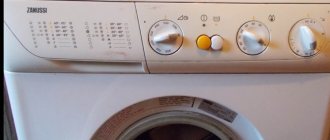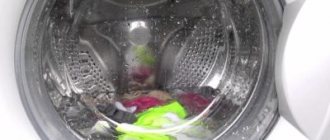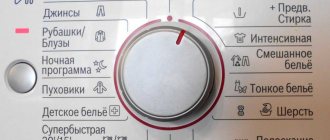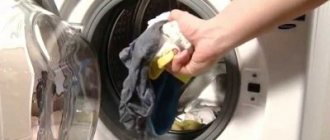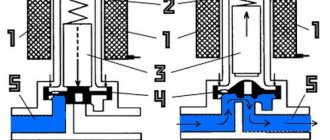Samsung washing machine does not spin or drain water? You must understand that this is a technically complex device. If in semi-automatic washing machines the control was handled by the owner himself, then in modern models the equipment will do everything for the user. All you need to do is put the laundry in the drum, fill the equipment with detergents and activate the appropriate program.
An ordinary washing machine is now equipped with a small, simple computer. Naturally, the increase in the number of functions had a negative impact on the reliability of the equipment. There are more and more components in washing machines that can fail.
What to do if the equipment does not spin things out and does not drain the water? Why is this happening? It is necessary to remember that the devices have a certain washing algorithm. The equipment cannot start the next stage until the previous one is completed.
Therefore, the spin cycle will not start until the machine has drained the liquid after washing. Probably this procedure is the reason. It is necessary to look for the problem step by step, to understand why the drainage of water into the sewer does not work.
The washing machine does not spin clothes after washing: 10 reasons for failure
In order for your equipment to serve for a long time and there are no questions about why the washing machine does not spin clothes, it must be used carefully and the following rules must be followed:
- You need to keep an eye on your pockets; small items can get stuck in the filter.
- Install a voltage regulation surge protector at home. Voltage fluctuations can undermine the control system of household appliances.
- Washing powder should be added only in the required quantity.
- Do not overload the washing machine.
- Take the dispenser and rid it of particles of washing powders and gels.
- Wash the area where the dispenser is installed and use a rag to clean it until it is dry.
- Clean the cuff on the door from various debris such as clothing threads, powder particles or other detergents.
- Close the door only after the drum and internal parts of the washing machine are dry.
- There is no need to clean the drum with highly concentrated detergents.
- After washing, ventilate the room and do a wet cleaning. Check to see if there is any leakage from the washing machine; if it does, double-check all parts of the machine.
Although many problems arise in the operation of household appliances, especially with a washing machine, if you do not have the appropriate skills, then it is better not to try to repair the machine yourself, because you may inadvertently touch some important part.
If the washing machine stops spinning, it is better to call a professional technician from the service center.
This will save your nerves and household appliances; no one knows what to do better than a master. Remember, a spin that stops working properly is a reason to immediately contact a professional.
A modern “smart” and easy-to-use washing machine is an indispensable household appliance. The machine not only washes, but also rinses and spins clothes after washing.
If the washing equipment does not spin out the laundry, it is faulty. There are many possible breakdowns. Some of them are serious (you will need the help of a specialist), while others are quite easy to fix on your own.
Some useful tips
Before we begin describing the simplest washing method itself, we will give a few recommendations that may be useful to you in the future.
Hand washing is, in fact, very similar to baking, for example, cookies in the oven. First you need to do the most thorough preparation, and then you need to do nothing almost all the time. Hand washing can easily be combined with other household chores. While your laundry is soaking or draining, you can freely do other household chores.
If you decide to wash your laundry by hand, don't accumulate too much laundry. Do a little laundry every day, or choose to do laundry 1-2 days a week.
If a stain appears on clothing, wash it immediately. Subsequently, the stain will absorb more strongly and dry out. It will be much more difficult to wash it off.
When washing clothes by hand for the first time, you don't even have to add powder. After soaking items that have previously been washed in the washing machine, you will be surprised at how much detergent is left on them. You may have to add powder, but not in too large quantities. In any case, when washing clothes by hand, never add too much detergent. Otherwise, it will be very difficult for you to rinse things until clear water later.
It is best to wash clothes by hand directly in the bathtub. Place a bucket in the bathtub and you won't have to worry about flooding the floor.
Operating the washing machine
To understand what to do if your Samsung washing machine begins to malfunction, that is, there is no function of spinning and removing water from the structure, it is important to consider each error in detail. There are many reasons, but experts in the field of washing equipment repair highlight several key ones.
Sewerage
To check if this is the problem, you need to unscrew and remove the drain hose and direct it into the bathtub, then start the spin or drain mode. If the water is removed freely, then the cause of the breakdown is not in the Samsung washing machine, but in the sewer. The problem is corrected by cleaning the sewer system at the exit point.
Drain hose
A clogged drain hose is the most common problem, as the cause of the malfunction can be a coin, a clump of hair, or a small object like a button that accidentally gets into the system. This is very difficult to determine, so it is important to check the entire system using steps such as:
- The Samsung washing machine needs to be placed on its side.
- The motor is covered with a plastic bag to prevent moisture from entering.
- The drain hose is disconnected from the pump and carefully pulled out of the machine so as not to touch other parts.
- The hose is washed and cleaned to remove the blockage.
- Installed in place.
- All work is performed in reverse order to restore the device to functionality.
This problem is extremely rare, but you need to know that it has a right to exist. When air gets into the pump, the Samsung machine begins to hum loudly, without draining the water after spinning.
You can fix the problem by pulling the drain hose into the bathroom, after which the drain mode is started to eliminate all the liquid and air that has collected inside the system.
Pump clogged
To fix this problem, you need to unscrew the cap and remove the concentrator, thoroughly cleaning it. It also eliminates blockages on the impeller, which is responsible for the normal functioning of the pump.
To avoid such a problem, it is recommended to collect small parts in special bags when washing so that they do not fall into important structural components of the Samsung washing machine.
The module is the heart and brain of a Samsung washing machine, so if the contacts burn out, the only solution is to replace the part with a new one.
Pump failure
The pump is a small electric motor that can fail due to constant blockages, so it is recommended to clean it in a timely manner to eliminate more general breakdowns. But, as practice shows, under certain conditions the unit can be repaired using the services of professionals.
Wash
After you have dealt with all the stains, you can proceed to the actual hand washing. Take the 20 minutes that have already lain. things in the water, wring them out and put them in a bucket. Use enough clothes at a time to fill no more than half the bucket.
Pour warm, almost hot water into a bucket and add 2-3 tsp. detergent. When filling the bucket, make sure there is not too much water. It should cover the clothes by 3-5 cm. Otherwise, you will spill everything during washing.
Take a plunger and start working with it as if, for example, you were cleaning a sink. A plunger will tighten your clothing by pushing soapy water through the thickness of your clothing. Run the plunger for 5 minutes, then simply leave the clothes in the bucket for 15 minutes.
After 15 minutes, work the plunger a little more. Remove the washed clothes from the bucket into the bathtub. Leave it to drain for 15 minutes.
“We are still friends”: Derevianko commented on the breakup with his wife
A student at the Vietnam Police Academy shared how she takes care of her facial skin.
Women's jeans: before you buy them, you need to pay attention to one detail
Possible reasons
If a Samsung washing machine does not drain, what reasons can be identified? The question is relevant among those people who actively use this type of household appliances, and therefore try to extend their service life without compromising their functional qualities.
We suggest you familiarize yourself with How to remove the drain hose of a Bosch washing machine
Experts identify the following main reasons when a Samsung washing machine does not spin or drain water:
- Blockage. If the drain hose from the pump becomes clogged with debris, the water drainage system is blocked, which is why the machine cannot wring out things and remove excess moisture. As a rule, such a malfunction appears if the hoses and pump are not cleaned in a timely manner, since these are the parts in the design of the washing machine that are considered the most vulnerable and require careful attention.
- Mechanical or electronic pump system. If the pump fails, the washing machine “freezes”, which is why the water does not drain.
- Pressostat. This is a level sensor that controls the amount of waste water in the system, so if it fails, the normal functioning of the Samsung washing machine is disrupted. In this regard, in addition to the pump, it is also necessary to check it.
- Control module. This is the most serious and costly breakdown, since it requires restoration of all the electrical equipment in a Samsung washing machine, and this is a large expense that not everyone can afford. In most cases, it will be cheaper to replace the washing machine with a new one than to eliminate all the breakdowns caused by non-functioning electronics. Therefore, the drain mechanism is only an additional malfunction against the background of a general breakdown.
In order to prevent problems with spinning, before starting the wash, you need to check your pockets for the following items:
- cigarettes;
- coins;
- tokens;
- watch;
- batteries.
The presence of such things can negatively affect the operation of the washing machine filter.
Buy only high-quality washing powders and pour them in the required proportions; there is no need to try to save money or, conversely, add more powder. It is noted that an excess amount of washing powder can contribute to the failure of the water level sensor.
Using surge protectors will protect your washing machine from voltage fluctuations. Remember that flashing and replacing boards is an expensive proposition.
The device must be kept clean on the outside and the inside must be constantly cleaned such as the drum and rubber band. The air conditioner and powder container also need to be cleaned of internal debris.
All these measures will help avoid breakdowns, and keeping the device clean will significantly extend its service life.
After washing, leave the machine door open so that the device has time to dry from the inside.
Do not use detergents containing strong acids. They dissolve the protective layer of the drum, and it will begin to rust.
If you want to keep your equipment, just call a technician from the service center, he will answer why the spin cycle is not working.
The slightest malfunction can cause the entire machine to break down. Although the manufacturer provides a high warranty during operation, any element of equipment is not insured against breakdown.
In addition to poor-quality spinning or its complete absence, equipment can signal a breakdown in another way, namely, by making unusual loud sounds - noise, humming, ringing, etc.
The following recommendations will help you figure out what the cause may be and how to eliminate it.
After the selected equipment is delivered home, buyers, as a rule, save on the cost of installing the machine and deal with the procedure themselves.
Connecting the product to the water supply and sewer system is quite simple. But they forget to remove the mounting bolts that secure the drum during transportation.
If the transport bolts are not removed, then when you first start the washing machine it starts to make a loud noise.
After discovering this problem, you should unscrew the remaining bolts and check the operation of the equipment again.
When placing items to be washed in the drum, it is imperative to check for various items in your pockets - keys, coins, receipts or receipts.
When they get into the drum or tank of the machine, you can hear a tapping sound.
Objects that fall into the machine can cause serious damage to it and damage some parts. Moreover, small elements often fall into the holes of the drum, after which they are difficult to get out
Also, items that are decorated with metal rivets, large zippers with fasteners, chains, etc. can make noise when washing. To prevent them from knocking on the drum, you should turn the items inside out and then just place them in the washing machine.
The drum in the washing machine rotates thanks to bearings. If parts are damaged, the drum stops rotating correctly and makes uncharacteristic noise.
To check whether this is the cause, you need to rotate the empty drum from side to side. When bearings wear out and fail, they prevent free rotation and play is felt. During washing, the equipment makes a lot of noise and may vibrate.
Most often, damage to parts is caused by wear of the oil seal: streaks of rust may appear on the machine. They can be seen if you remove the back cover from the product body.
If the cause is correctly determined, the bearings should be replaced.
To do this you will need to perform the following list of actions:
- Disconnect the washing machine from the sewer, water supply, and turn off the power.
- Disassemble the rear and top panels according to the instructions.
- Remove the dispenser and control unit by unscrewing the screws.
- Loosen the clamp, remove the counterweight, heating element, pipes and other parts that prevent access to the engine.
- Remove the motor.
- Remove the drum tank.
- Unscrew the drum to remove the pulley and unscrew the shaft.
- Knock out the bearing using a special tool - a knockout.
- Replace the seals.
- Install the new bearing into the seat.
- Reassemble the equipment in reverse order.
It is better to coat the tank connection points with a sealant. For convenience and to remember the order of the procedure, all steps taken can be recorded using photos or videos.
A characteristic sign of a weakened pulley is the presence of a click when the drum rotates. The identified problem is resolved quickly enough. Disassembling the washing machine is performed in the same manner as when replacing bearings.
You can tighten the pulley using a specially selected wrench - you need to fix the loose fasteners. For greater reliability, the bolt should be treated with sealant
After completing the procedure, you will need to check whether the washing machine makes noise during the spin cycle. It is better to run a short wash program with twisting to make sure it works correctly.
We invite you to familiarize yourself with Colored laundry washing in the machine
In order to hold the tank while washing, the machine is equipped with counterweights. If you hear a loud noise during operation, you should check whether the fastenings of this unit are loose.
The bolts may become loose as a result of using the machine for a long time, and a new product may have a manufacturing defect. In the latter case, the equipment is subject to warranty repair.
If the unit fails, you will need to remove the panels of the machine and unscrew all the parts that prevent free access to the counterweights. Next, you need to check their integrity and secure the fastenings more tightly.
When installing a washing machine, users do not always pay attention to the quality of the floor surface and the presence of unevenness on it.
As a rule, tiles are quite slippery and the machine can move on the floor. To do this, you need to glue rubber tips to the legs if they are missing.
The equipment should be installed according to the instructions, using a level or glass of water. If the surface is uneven, you can place a flat surface made of wood or other dense material under the washing machine.
Stores also sell special rubber installation mats.
Increased noise levels may not cause any damage. Some budget cars are very noisy.
When purchasing a product, you should definitely be interested in this characteristic. The indicator in the equipment passport is indicated in dB. Quieter models do not exceed 54 dB during washing and 65 dB during twisting.
Some models of machines with a direct drive type - inverter washing machines - have low noise levels.
If a problem with increased noise is detected, you must check the product specifications specified in the documentation.
Two faults in the water drainage system
According to professionals, the frequency of spin system breakdowns primarily depends on the model of the washing machine.
- the liquid does not drain to the drum, as a result of which the sensor turns off the spin cycle;
- the drain seems to work normally, but at the end of the wash the laundry remains damp;
- very low water drainage rate;
- spinning does not work properly.
Malfunctions of the tachometer can also cause the washing machine to stop spinning.
The next reason is interruptions in the operation of the sensor for fixing the drum.
The drum speed is regulated by a sensor mounted on the motor shaft. It records the revolutions per minute. If the wires are burned there, then the signal simply does not reach the automatic system. The number of revolutions does not change, and because of this it is impossible to wring out the laundry.
If the washing machine does not spin, then the reason may also be that the motor is not working.
The motor is the center of gravity and the heart of every technology. As a result of its malfunction, a short circuit or wire break may occur, which will directly affect the washing machine.
It is possible that the graphite brushes in the motor have worn out. If this is the case, you don’t have to worry yourself about trying to fix the machine, just invite a person from the service center.
Well, another common reason why a washing machine does not spin clothes is problems with the electrical module.
Many expensive models are equipped with an electrical module. The module is based on a stabilizer. If the stabilizer is faulty, this will cause the module to stop issuing the necessary commands. In this case, the drum rotates, but the spin mode does not work. Call the technician urgently, he will do the firmware or simply install a new stabilizer.
More serious problems with the washing unit are likely when the laundry is not just left unwrung in a small amount of water, but floats in it.
If the washing machine does not drain the water from the tank, problems have arisen in the water drainage system:
- The drain filter, hose, and pipe are clogged.
- Any of these parts or the drain pump (pump) has broken.
The easiest way is to remove the blockage in the drain filter (and this should be done regularly for prevention). It is more difficult to solve the problem with the drain hose going into the sewer. It is even more difficult to disassemble the machine and clean the pipe coming from the pump.
As for replacing the pump itself (it often “burns out”), only an experienced specialist can do it.
For more information about the problem of water not draining, read “The washing machine does not drain water.”
What you can do yourself
To the delight of Samsung owners, we will say that the lack of a spin cycle does not always indicate a breakdown of the washing machine. The following reasons can lead to this, which you can deal with yourself.
- Selecting a program without spinning. Any modern machines, including Samsung, have a number of programs without spinning. As a rule, this is a “delicate” wash, “silk”, “wool”. Check which mode was originally selected. Perhaps the program did not involve spinning.
- Overloading the machine with laundry . If you put more things in the drum than the instructions say, the motor may not have enough power to spin the drum. As a result, the spin is absent or of poor quality. Try removing some of the items from the machine and restarting the spin cycle.
- Washing one but bulky item . When washing a large item, such as a blanket, plaid, or down jacket, the washing machine often cannot distribute it evenly on the drum, a load imbalance is recorded, so the machine does not spin. Try to manually spread the item on the drum as evenly as possible. In the future, try to have large items dry-cleaned or wash them in specialized laundries (machines installed there usually have a larger capacity than domestic ones).
- Things have gathered in a ball . The traditional situation is that the pillowcase or duvet cover “ate” all the other things. The machine cannot arrange things on the drum and, due to load imbalance, does not spin. It is necessary to manually sort things into the drum.
- Uneven installation of the SMA . If the machine is not level, skew often occurs and the laundry is poorly distributed throughout the drum. As a result, an imbalance occurs and the machine does not spin. You need to install the washing machine correctly by adjusting the legs.
- One-time failure of the control unit. Sometimes Samsung machines freeze. To fix the problem, you need to disconnect the washing machine from the power supply for 10-15 minutes. If, after switching on, the spin worked normally, it was a one-time failure, and the equipment was in perfect order.
Preventing breakdowns in washing machines
It is possible to anticipate the occurrence of problems associated with increased noise levels, strong vibrations, and lack of a spin function if you adhere to the basic recommendations for the care and operation of equipment.
Experts advise doing the following with washing machines:
- load the volume of things without exceeding that specified in the machine’s passport;
- check for foreign objects in pockets;
- use covers for washing small items;
- less often include programs that involve working at high speeds and using hot water;
- clean filters regularly;
- Use only high-quality detergents and water softeners for washing.
In case of power surges, it is advisable to connect equipment to the network through surge protectors with a fuse or use a stabilizer.
Proper care and high-quality prevention will prevent malfunctions in the operation of the machine. You can learn about the weaknesses of individual brands from user reviews
If problems are identified, it is necessary to diagnose the product and replace failed components for the correct operation of the machine.
Timely and correct replacement of parts will extend the life of the equipment and prevent more serious breakdowns.
Hand washing using a new method: what you need
To quickly and easily wash dirty clothes by hand, prepare:
It’s good to wash often: myths about shampoo and hair care that only harm
Rare shot: Viktoria Isakova showed her grown-up daughter from Yuri Moroz (new photo)
"Dad is offended." Agata Muceniece about her relationship with Priluchny after the divorce
- large bucket;
- toothbrush and silicone grater;
- stain remover (you can make it yourself);
- laundry detergent or soap;
- plunger with a long handle.
You need to buy a bucket that is tall enough and definitely voluminous. A classic plunger for hand washing using this method is best - made of thick rubber with a wooden handle. Of course, for washing you will need to buy a new plunger, one that has not yet been used for its intended purpose.
To remove stains, you may also need hydrogen peroxide and any dish detergent.
Five breakdowns that require specialist intervention
A washing machine that has stopped spinning clothes will need professional repairs due to the failure of one of the important parts or components.
A faulty tachometer (a device that records the number of revolutions of the washing machine drum) is the first possible reason for the lack of spin.
A broken tachometer transmits incorrect data or does not contact the control module of the washing machine at all.
Solving the problem with the tachometer:
- Checking its fastenings, wires, contacts. Accordingly, if necessary, they are tightened, isolated, and cleaned.
- Replacing the tachometer with a new one if the old one is no longer repairable.
The tachometer is located on the shaft of the electric motor (motor) of the washing machine. To get to it, you will need to disassemble the washing unit.
The second probable and quite serious malfunction is a breakdown of the electric motor of the machine itself. Therefore, after checking the tachometer, check the motor.
To diagnose a breakdown of the electric motor, the technician disassembles the washing machine, disconnects the belt and wires from the motor, unscrews it and checks:
- coils,
- commutator brushes.
Wear on the electric motor brushes is one of the most common malfunctions of washing machines of any brand and model. When the brushes wear out, the motor slows down and the machine spins poorly.
Faulty elements of the electric motor, as well as the motor itself, are replaced with new ones.
The third probable cause of a malfunction of the washing machine is a breakdown of the pressure switch (water level sensor). In this case, the spin cycle will not start because the control module of the washing machine “does not know” how much water is in the tank (whether it is there or not). The faulty pressure switch is replaced with a new one.
The fourth reason is a malfunction of the water heater. Excessive scale formation on the heating element, as well as its “burnout”, can serve as a signal to the control unit to turn off the spin cycle.
The fifth and most serious failure of the washing machine, when it does not spin clothes, is a malfunction of the electronic control module. It needs to be reflashed or replaced with a new one.
To carry out professional diagnostics and prompt repair of a washing machine that does not spin clothes, invite a certified VseRemont24 specialist to your home at any convenient time!
How is the UE code deciphered?
The UE error indicates that the drum load is unbalanced. In older models produced before 2007, this problem is indicated on the display by code E4. Do not confuse this with code 4E, which indicates a problem with water supply. Usually the indication appears at 3, 7 or 9 minutes of spinning. During this time, the machine attempts to start the last stage of washing. If it fails, you see the UE code on the display.
To determine the severity of the breakdown at the initial stage, try running a single wash cycle. If the error occurs even when the drum is unloaded, the washing machine will most likely need serious repairs. The absence of a code on the display and the free start of the spin cycle after unloading the unit indicate a problem that can be easily fixed with your own hands.
Two faults in the water drainage system
The proposed videos will help you independently determine the cause of increased noise in the machine or lack of spin, as well as replace components and parts with your own hands.
Repairing a washing machine usually does not take much time, but initial skills are required to identify the cause of noise and other problems, as well as to replace spare parts or even basic cleaning.
If you doubt your abilities, it is better to contact a service center, where, after an initial diagnosis, they will quickly determine the cause of the breakdown and indicate the cost of repairs.
Have you ever repaired a washing machine yourself? Please tell us what kind of breakdown you encountered and whether you were able to fix the equipment. We are waiting for your comments, questions and advice on repairing your washing machine - the contact form is located below.
When the machine needs to be repaired in a workshop
If the washing machine, after carrying out preventive measures and using different loading configurations, still does not spin clothes well, then the reasons may be serious, and the equipment should be repaired by a specialist. You should contact the workshop in the following cases.
- Software failure. The machine does not operate according to the set mode.
- Engine failure. The cause of the problem may be the belt and brushes. The technician will determine the specific problem after disassembling the washing machine body.
- The bearings are worn out and need to be replaced.
- The pump problem can be solved by installing a new one.




